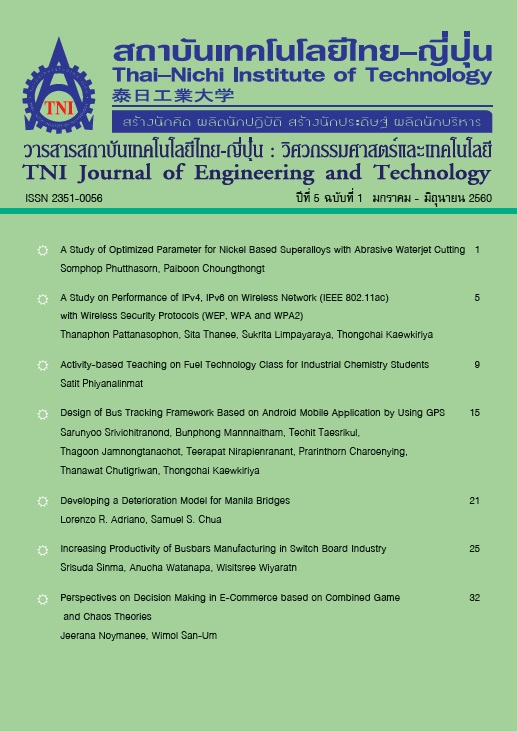Perspectives on Decision Making in E-Commerce based on Combined Game and Chaos Theories
Main Article Content
บทคัดย่อ
This paper presents new paradigm on behaviours of decision making in E-commerce in Thailand through a perspective on game Theory and a chaos theory. As E-commerce is a multi-dimensional consideration, a single theory may not be sufficient for the overall perspective views in decision making. In this paper, game theory is suitable for decision making of E-commerce providers in order to set the strategy based on feedback information. However, chaos theory is suitable for describing customer decision making, especially the buying behaviors seems to be random in which the classical decision model cannot be described. The proposed new paradigm can be applicable for economics and managements in enterprise, especially business-tocustomer types of entrepreneurs.
Article Details
นโยบายการรับบทความ
กองบรรณาธิการวารสารสถาบันเทคโนโลยีไทย-ญี่ปุ่น มีความยินดีรับบทความจากอาจารย์ประจำ และผู้ทรงคุณวุฒิในสาขาวิศวกรรมศาสตร์และเทคโนโลยี ที่เขียนเป็นภาษาไทยหรือภาษาอังกฤษ ซึ่งผลงานวิชาการที่ส่งมาขอตีพิมพ์ต้องไม่เคยเผยแพร่ในสิ่งพิมพ์อื่นใดมาก่อน และต้องไม่อยู่ในระหว่างการพิจารณาของวารสารอื่นที่นำส่ง ดังนั้นผู้สนใจที่จะร่วมเผยแพร่ผลงานและความรู้ที่ศึกษามาสามารถนำส่งบทความได้ที่กองบรรณาธิการเพื่อเสนอต่อคณะกรรมการกลั่นกรองบทความพิจารณาจัดพิมพ์ในวารสารต่อไป ทั้งนี้บทความที่สามารถเผยแพร่ได้ประกอบด้วยบทความวิจัย ผู้สนใจสามารถศึกษาและจัดเตรียมบทความจากคำแนะนำสำหรับผู้เขียนบทความ
การละเมิดลิขสิทธิ์ถือเป็นความรับผิดชอบของผู้ส่งบทความโดยตรง บทความที่ได้รับการตีพิมพ์ต้องผ่านการพิจารณากลั่นกรองคุณภาพจากผู้ทรงคุณวุฒิและได้รับความเห็นชอบจากกองบรรณาธิการ
ข้อความที่ปรากฏภายในบทความของแต่ละบทความที่ตีพิมพ์ในวารสารวิชาการเล่มนี้ เป็น ความคิดเห็นส่วนตัวของผู้เขียนแต่ละท่าน ไม่เกี่ยวข้องกับสถาบันเทคโนโลยีไทย-ญี่ปุ่น และคณาจารย์ท่านอื่น ๆ ในสถาบัน แต่อย่างใด ความรับผิดชอบด้านเนื้อหาและการตรวจร่างบทความแต่ละบทความเป็นของผู้เขียนแต่ละท่าน หากมีความผิดพลาดใด ๆ ผู้เขียนแต่ละท่านจะต้องรับผิดชอบบทความของตนเองแต่ผู้เดียว
กองบรรณาธิการขอสงวนสิทธิ์มิให้นำเนื้อหา ทัศนะ หรือข้อคิดเห็นใด ๆ ของบทความในวารสารสถาบันเทคโนโลยีไทย-ญี่ปุ่น ไปเผยแพร่ก่อนได้รับอนุญาตจากผู้นิพนธ์ อย่างเป็นลายลักษณ์อักษร ผลงานที่ได้รับการตีพิมพ์ถือเป็นลิขสิทธิ์ของวารสารสถาบันเทคโนโลยีไทย-ญี่ปุ่น
ผู้ประสงค์จะส่งบทความเพื่อตีพิมพ์ในวารสารวิชาการ สถาบันเทคโนโลยีไทย-ญี่ปุ่น สามารถส่ง Online ที่ https://www.tci-thaijo.org/index.php/TNIJournal/ โปรดสมัครสมาชิก (Register) โดยกรอกรายละเอียดให้ครบถ้วนหากต้องการสอบถามข้อมูลเพิ่มเติมที่
- กองบรรณาธิการ วารสารสถาบันเทคโนโลยีไทย-ญี่ปุ่น
- ฝ่ายวิจัยและนวัตกรรม สถาบันเทคโนโลยีไทย-ญี่ปุ่น
เลขที่ 1771/1 สถาบันเทคโนโลยีไทย-ญี่ปุ่น ซอยพัฒนาการ 37-39 ถนนพัฒนาการ แขวงสวนหลวง เขตสวนหลวง กรุงเทพมหานคร 10250 ติดต่อกับคุณพิมพ์รต พิพัฒนกุล (02) 763-2752 , คุณจุฑามาศ ประสพสันติ์ (02) 763-2600 Ext. 2402 Fax. (02) 763-2754 หรือ E-mail: JEDT@tni.ac.th
เอกสารอ้างอิง
“The National Statistics Office (NSO).” [Online]. Available: https://www.nso.go.th/sites/2014.
F. Bernstein, J.-S. Song, and X. Zheng, “‘Bricks-and-mortar’ vs. ‘clicks-and-mortar’: An equilibrium analysis,” European Journal of Operational Research, vol. 187, no. 3, pp. 671–690, Jun. 2008.
D. Sun, E. Li, and J. C. Hayya, “The optimal format to sell a product through the internet: Posted price, auction, and buy-price auction,” International Journal of Production Economics, vol. 127, no. 1, pp. 147–157, Sep. 2010.
E. Anshelevich, F. B. Shepherd, and G. Wilfong, “Strategic network formation through peering and service agreements,” Games and Economic Behavior, vol. 73, no. 1, pp. 17–38, Sep. 2011.
J. Yu and B. Xu, “The game analyses to price the target enterprise of merger and acquisition based on the perspective of real options under stochastic surroundings,” Economic Modelling, vol. 28, no. 4, pp. 1587–1594, Jul. 2011.
Y. Xiong, W. Yan, K. Fernandes, Z.-K. Xiong, and N. Guo, “‘Bricks vs. Clicks’: The impact of manufacturer encroachment with a dealer leasing and selling of durable goods,” European Journal of Operational Research, vol. 217, no. 1, pp. 75–83, Feb. 2012.
U. F. Ott, “International Business Research and Game Theory: Looking beyond the Prisoner’s Dilemma,” International Business Review, vol. 22, no. 2, pp. 480–491, Apr. 2013.
Q. Lu and N. Liu, “Pricing games of mixed conventional and e-commerce distribution channels,” Computers & Industrial Engineering, vol. 64, no. 1, pp. 122–132, Jan. 2013.
W. Cho, R. Subramanyam, and M. Xia, “Vendors’ incentives to invest in software quality in enterprise systems,” Decision Support Systems, vol. 56, pp. 27–36, Dec. 2013.
S. Karray and S. P. Sigué, “A game-theoretic model for co-promotions: Choosing a complementary versus an independent product ally,” Omega, vol. 54, pp. 84–100, Jul. 2015.
T. Mouck, “Capital markets research and real world complexity: The emerging challenge of chaos theory,” Accounting, Organizations and Society, vol. 23, no. 2, pp. 189–215, Feb. 1998.
D. Guégan, “Chaos in economics and finance,” Annual Reviews in Control, vol. 33, no. 1, pp. 89–93, Apr. 2009.
B. Volná, “Existence of chaos in the plane R2 and its application in macroeconomics,” Applied Mathematics and Computation, vol. 258, pp. 237–266, May 2015.
A. Matsumoto, “Attractors, Bifurcations and Chaos: Nonlinear Phenomena in Economics,” Journal of Economic Behavior & Organization, vol. 58, no. 4, pp. 550–554, Dec. 2005.


